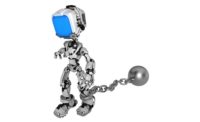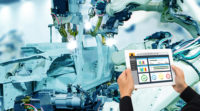Robots and other automation technologies have greatly increased productivity in today’s factories. However, they still have one major limitation: They require people to tell them what to do.
But, what if robots and other industrial machinery could teach themselves how to perform a task? This is the goal of a joint venture created in April 2018 by Hitachi, Fanuc and Preferred Networks, a startup specializing in artificial intelligence (AI).
The new company, Intelligent Edge System, will develop fast, real-time control systems for network-linked robots and machine tools. By utilizing deep-learning AI technology, these control systems will learn and become smarter as linked machines manufacture products.
Deep learning is a type of AI technology designed to mimic the human brain’s functions to sift through information more efficiently and speed up data analysis. The technology promises to boost assembly line productivity by making it possible for robots to recognize different parts and adjust their moves accordingly. It could also enable robots to automatically take on the task of an adjacent robot on an assembly line if it breaks down.
Edge computing will also play a major role in the joint venture’s control systems. Instead of centrally processing data, the technology handles the task at the edge of the network, letting machines on assembly line immediately process the massive amount of data collected from vision systems, sensors, grippers and tools.
Already, the new company’s efforts are paying off. For example, Fanuc has introduced an AI-based system to enable robots to pick parts from a box, tray or conveyor with a high rate of success. Using deep learning and a scoring system for 3D objects, the robot automatically determines which parts to pick up, how to pick them up, and in what sequence. Without AI, such an application would require hours of detailed parameter tuning by an experienced engineer.
With AI, the robot trains itself. Each time the robot succeeds or fails to pick up a part, it remembers how the object looked. That data is then used to refine a deep-learning model that controls the robot’s action. With a few hours of practice, the robot eventually learns pick parts with an accuracy of 90 percent or better.
Fanuc is also applying deep-learning software to automatically tune and control servomotors that drive cutting tools in CNC machining centers; to automatically compensate for thermal displacement in electric discharge machining applications; and to accurately predict when valves and other “wear and tear” components on injection molding machines need to be replaced.
AI isn’t only being applied to robots. It’s being applied to robot peripherals, as well. For example, at this year’s Hannover Messe trade show in Germany, SCHUNK and French AI startup AnotherBrain announced an agreement to develop the world’s first autonomously acting gripping system by next year. The gripper will be able to operate independently, without the need for manual programming.
“This promising cooperation will help us to push forward the use of artificial intelligence in the field of handling and assembly, and to create new handling scenarios in the smart factory—and also in the field of service robotics,” says SCHUNK CEO Henrik A. Schunk.
Instead of having an engineer define positions, speeds and gripping forces step by step, autonomous gripping systems will detect their target objects via cameras, and then independently take over the planning of the gripping process and continuously improve it. The quality of the grip can be detected, evaluated, and readjusted as necessary. Sensors in the gripper’s motors and fingers would provide data to on-board intelligence.
Machines Get Smart
A 2018 survey by Forbes magazine found that half of U.S. manufacturers believe AI and machine learning will be “absolutely critical” to their success in the next five years. These technologies are about more than just gathering data from connected systems. They will create smart machines that can use the data to sense, understand, learn and take actions independent of human direction.
Although AI and machine learning are often used interchangeably, they’re not quite the same. AI is the broader concept of simulated human intelligence by machines and computer systems. Machine learning is a form of AI that enables a system to learn from data rather than through programming. Algorithms build a mathematical model of sample data, known as “training data,” to make predictions or decisions without being explicitly programmed to perform the task. This is how spam filters work in email software.
In manufacturing, AI and machine learning are already being applied to vision systems, CAD software and predictive maintenance. The technologies are also being used to aid demand forecasting, personalize manufacturing, optimize manufacturing processes, automate material procurement, and even screen sales leads.
For example, IBM’s Prescriptive Warranty for Manufacturing software applies advanced analytics to warranty-related data to help identify where warranty-eligible defects are arising and determine why they are occurring, enabling companies to respond more quickly and efficiently.
The software looks for conditions that lead to accelerated wear and replacement of manufactured products that are under warranty. Such conditions might include variations in the manufacturing process of the product, variations in the quality of parts and materials that are used in the product, or the ways in which the product is used.
Better Batteries Through AI
In March, scientists at the Massachusetts Institute of Technology, Stanford University and the Toyota Research Institute discovered that combining comprehensive experimental data and artificial intelligence can accurately predict the useful life of lithium-ion batteries before their capacities started to wane.
After the researchers trained their machine learning model with a few hundred million data points, the algorithm predicted how many more cycles each battery would last, based on voltage declines and other factors measured during early cycles. The predictions were within 9 percent of the actual cycle life.
Separately, the algorithm categorized batteries as having either long or short life expectancies based on just the first five charge-discharge cycles. Here, the predictions were correct 95 percent of the time.
This machine learning method could accelerate R&D of new battery designs, and reduce the time and cost of production.
“The standard way to test new battery designs is to charge and discharge the cells until they die. Since batteries have a long lifetime, this process can take many months and even years,” said co-lead author Peter Attia, Stanford doctoral candidate in materials science and engineering. “It’s an expensive bottleneck in battery research.”
Another focus of the project was to find a better way to charge batteries in 10 minutes, a feature that could
accelerate the mass adoption of electric vehicles. To generate the training data set for that application, the team charged and discharged batteries until each one reached the end of its useful life, which they defined as capacity loss of 20 percent. However, the researchers wondered whether it was necessary to run the batteries into the ground. Could the answer to a battery question be found in the information from just the early cycles?
“Advances in computational power and data generation have recently enabled machine learning to accelerate progress for a variety of tasks, including prediction of material properties,” says Richard Braatz, Ph.D., professor of chemical engineering at MIT. “Our results show how we can predict the behavior of complex systems far into the future.”
The researchers’ machine learning algorithms have many applications in battery manufacturing. For example, they can shorten the time for validating batteries with new chemistries, which is especially important given rapid advances in materials. Also, manufacturers can use their software to grade batteries. Units with longer lifetimes could be sold at higher prices for more demanding uses, such as powering electric vehicles. Recyclers can use the method to find cells in used EV battery packs that have enough life in them for secondary uses.
Yet another use is optimizing battery manufacturing. “The last step in manufacturing batteries is called ‘formation’ which can take days to weeks,” says Attia. “Using our approach could shorten that significantly and lower the production cost.”







